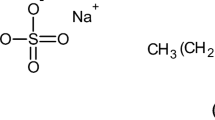Abstract
The swelling in water, as a function of temperature, of two series of N-isopropylacrylamide (NIPA Am) polymer networks was studied. In the first series, n-butylmethacrylate (BMA) was copolymerized with NIPA Am, and in the second, polytetramethylene ether glycol (PTMEG) was incorporated into NIPAAm network as a chemically independent interpenetrating network. With increasing BMA content in the poly(NIPAAm-co-BMA) network, the gel collapse point was lowered and the gels deswelled in a more gradual manner with increasing temperature. In the interpenetrating polymer networks (IPN) system, the gel collapse point was not significantly changed by the amount of incorporated PTMEG. In DSC thermograms of swollen samples, the shape and onset temperature of the endothermic peak corresponded to the gel deswelling behavior and gel collapse point. The temperature dependence of equilibrium swelling in water was shown to be a function of the gel composition in both network series. The synthesized networks formed a dense surface layer as the temperature increased past the gel collapse point. This dense layer retarded water efflux and thereby resulted in water pockets at the membrane surface.
Similar content being viewed by others
REFERENCES
N. A. Mazer. Pharmacokinetic and pharmacodynamic aspects of polypeptide delivery. J. Control. Rel. 11:343–356 (1990).
J. Kost, K. W. Leong, and R. Langer. Ultrasonic controlled polymeric delivery. Proc. Int. Symp. Control. Rel. Bioact. Mater. 10:84–85 (1983).
Y. H. Bae, T. Okano, and S. W. Kim. Thermo-sensitive polymers as on-off switches for drug release. Makromol. Chem. Rapid Commun. 8:481–485 (1987).
S. R. Eisenberg and A. J. Grodzinsky. Electrically modulated membrane permeability. J. Membr. Sci. 19:173–194 (1984).
P. I. Freeman and J. S. Rowlinson. Lower critical points in polymer solutions. Polymer 1:20–26 (1960).
D. Patterson. Free volume and polymer solubility. A qualitative view. Macromolecules 2:672–679 (1969).
A. H. Liddell and F. L. Swington. Thermodynamic properties of some polymer solutions at elevated temperatures. Disc. Faraday Soc. 49:115–120 (1970).
F. W. Billmeyer, Jr. Textbook of Polymer Science, 2nd ed., John Wiley & Sons, New York, 1970, pp. 39–41.
A. Silberberg, J. Eliassaf, and A. Kachalsky. Temperature-dependence of light scattering and intrinsic viscosity of hydrogen bonding polymers. J. Polym. Sci. 23:259–281 (1957).
Y. H. Bae, T. Okano, and S. W. Kim. Temperature dependence of swelling of crosslinked poly(N,N′-alkyl substituted acrylamides) in water. J. Polym. Sci. Part B Polym. Phys. 28:923–936 (1990).
L. D. Taylor and L. D. Cerankowski. Preparation of films exhibiting a balanced temperature dependence to permeation by aqueous solution—A study of lower consolute behavior. J. Polym. Sci. Polym. Chem. Ed. 13:2551–2570 (1975).
J. H. Priest, S. L. Murry, R. J. Nelson, and A. S. Hoffman. Lower critical solution temperatures of aqueous copolymers of N-isopropylacylamide and other N-substituted acrylamides. ACS Symp. Ser. 350:255–264 (1987).
Roberto F. S. Freitas and E. L. Cussler. Temperature sensitive gels as extraction solvents. Chem. Eng. Sci. 42:97–103 (1987).
Roberto F. S. Freitas and E. L. Cussler. Temperature sensitive gels as size selective absorbants. Separat. Sci. Technol. 22:911–919 (1987).
A. S. Hoffman, A. Afrassiabi, and L. C. Dong. Thermally reversible hydrogels. II. Delivery and selective removal of substances from aqueous solutions. J. Control. Rel. 4:213–222 (1986).
Y. Okahata, H. Noguchi, and T. Seki. Thermoselective permeation from a polymer-grafted capsule membrane. Macromol. 19:493–494 (1986).
L. C. Dong and A. S. Hoffman. Thermally reversible hydrogels. III. Immobilization of enzymes for feedback reaction control, J. Control Rel. 4:223–227 (1986).
T. G. Park and A. S. Hoffman. Effect of temperature cycling on the activity and productivity of immobilized galactosidase in a thermally reversible hydrogel bead reactor. Appl. Biochem. Biotech. 19:1–9 (1988).
S. Hirotsu, Y. Hirokawa, and T. Tanaka. Volume-phase transitions of ionized N-isopropylacrylamide gels. J. Chem. Phys. 87:1392–1359 (1987).
Y. Hirose, T. Amiya, Y. Hirokawa, and T. Tanaka. Phase transition of submicron gel beads. Macromol. 20:1342–1344 (1987).
E. S. Matsuo and T. Tanaka. Kinetics of discontinuous volume-phase transition of gels. J. Chem. Phys. 89:1695–1703 (1988).
S. Hirotsu. Critical points of the volume phase transition in N-isopropylacryamide gels. J. Chem. Phys. 88:427–431 (1988).
E. F. Cluff, E. K. Gladding, and R. Pariser. A new method for measuring the degree of crosslinking in elastomers. J. Polym. Sci. XLV:341–345 (1960).
Y. K. Sung, D. E. Gregonis, M. S. John, and J. D. Andrade. Thermal and pulse NMR analysis of water in poly(2-hydroxyethyl methacrylate). J. Appl. Polym. Sci. 26:3719–3728 (1981).
H. B. Lee, M. S. John, and J. D. Andrade. Nature of water in synthetic hydrogels. 1. Dilatometry, specific conductivity, and differential scanning calorimetry of polyhydroxyethyl methacrylate. J. Colloid Interface Sci. 51:225–331 (1975).
W. E. Roorda, J. A. Bouwstra, M. A. de Vries, and H. E. Junginger. Thermal behavior of poly hydroxy ethyl methacrylate (pHEMA) hydrogels. Pharm. Res. 5:722–725 (1988).
L. H. Sperling. Interpenetrating Polymer Networks and Related Materials, Plenum Press, New York, 1981.
A. Peters and S. J. Candau. Kinetics of swelling of polyacrylamide gels. Macromol. 19:1952–1955 (1986).
Y. Hirokawa, E. Sato, S. Hirotsu, and T. Tanaka. Critical kinetics of isopropylacrylamide gel swelling. Polym. Mater. Sci. Eng. 52:520–521 (1985).
Y. H. Bae, T. Okano, and S. W. Kim. “On-off” thermocontrol of solute transport. II. Solute release from thermosensitive hydrogels. Pharm. Res. 8:624–628 (1991).
Author information
Authors and Affiliations
Rights and permissions
About this article
Cite this article
Bae, Y.H., Okano, T. & Kim, S.W. “On–Off” Thermocontrol of Solute Transport. I. Temperature Dependence of Swelling of N-Isopropylacrylamide Networks Modified with Hydrophobic Components in Water. Pharm Res 8, 531–537 (1991). https://doi.org/10.1023/A:1015871732706
Issue Date:
DOI: https://doi.org/10.1023/A:1015871732706




